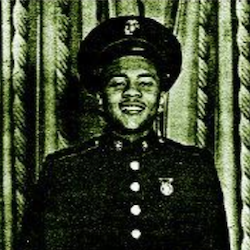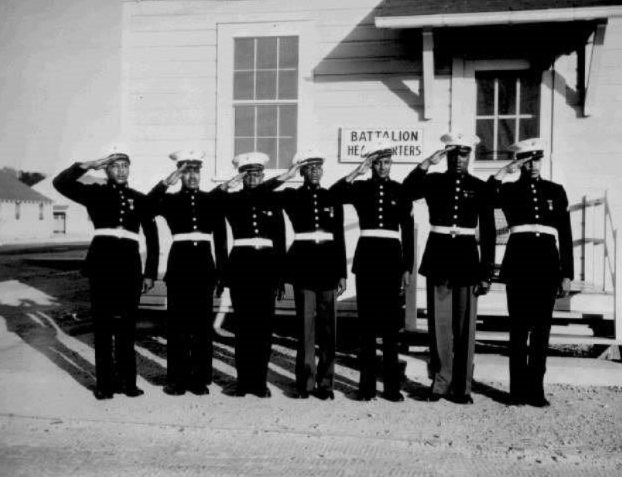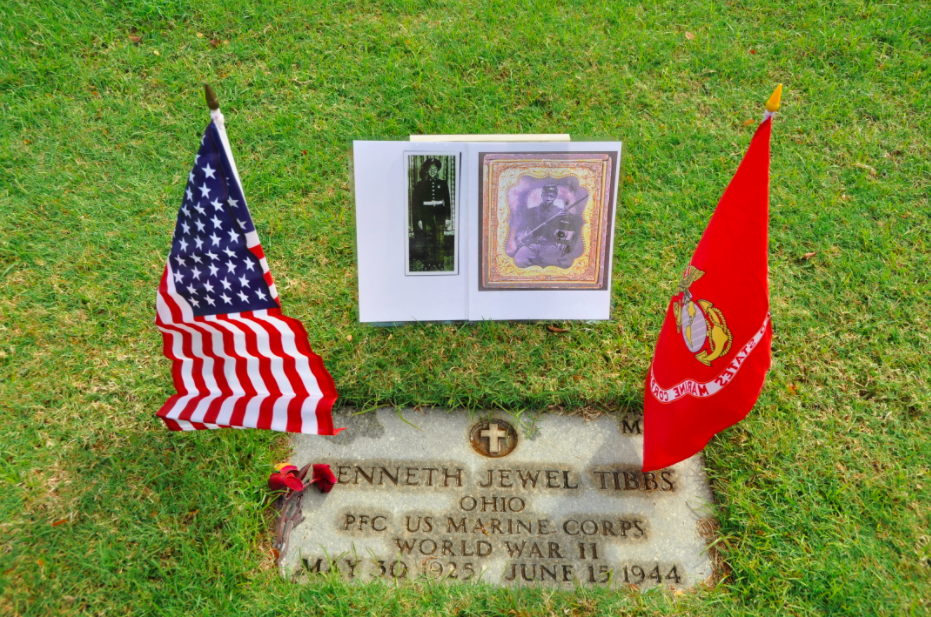Private First Class Kenneth Jewell Tibbs

- Unit: 20th Marine Depot Company, 7th Field Depot
- Service Number: 913263
- Date of Birth: May 30, 1925
- Entered the Military: October 14, 1943
- Date of Death: June 15, 1944
- Hometown: Lancaster, Ohio
- Place of Death: Saipan, Mariana Islands
- Award(s): Purple Heart
- Cemetery: Section, M Site 187. National Memorial Cemetery of the Pacific
Riverside National Cemetery
2016-2017
Early Life
Kenneth Tibbs was the third of seven children born to Albert and Florence Tibbs. Kenneth’s father, Albert, passed away when Kenneth was 13 years old. By age 15, Kenneth left school to help support his family.
Kenneth’s mother was a housewife and occasional day worker, and his stepfather, Melvin Brown, suffered from a heart condition and was unable to work. The family depended on Kenneth’s income. Prior to joining the military, he worked as an auto mechanic, a porter, and as a laborer for the Ralston Steel Car Company, a major employer in Columbus, Ohio.
On October 14, 1943, he enlisted in the U.S. Marine Corps. When Kenneth left for training in October, his girlfriend, Katherine Howell, was pregnant with his child.

Military Experience
Basic Training
Tibbs was part of the first group of African-American men inducted into the U.S. Marine Corps in fulfillment of Executive Order 8802. He traveled to Camp Montford Point in New River, North Carolina, where he entered basic training on October 29, 1943, at age 18.
Black recruits were prohibited from training with the white recruits at Parris Island, South Carolina. Conditions at Montford Point were physically and mentally challenging. Recruits lived in prefabricated huts with no running water or toilets. Public facilities outside of the base were segregated. Black Marines endured racial discrimination both on and off the post.
Throughout his service, he continued to support his mother, sending her $60 each month from his paycheck.
Tibbs was an exceptional Marine. He earned above average entrance aptitude scores and consistently received top marks on his professional and conduct reports. Kenneth desired to join the infantry. He was assigned to the 20th Marine Depot Company on February 22, 1944, and worked as the commander’s personal steward. He was promoted to Private First Class on April 28, 1944.
Headed to Battle
On February 26, 1944, Tibbs and the 20th Marine Depot Company deployed from Norfolk, Virginia, aboard the USS James O’Hara in support of Pacific Theater operations. They arrived at Pearl Harbor, Hawaii, on March 16. The company sailed aboard the S.S. Waialeale on April 28 from Honolulu to Maui. In May the company boarded the USS Pierce and arrived in Saipan in June 1944. On June 15, Tibbs’ unit joined Task Force 52 for the allied offensive on Saipan and Tinian.
Yellow Beach #2, Saipan
The Battle of Saipan on June 15, 1944, marked the beginning of the end of World War II in the Pacific. Allied planners chose to bypass Japanese forces in the Carolines and Palauan Islands and attack Saipan, located in the Mariana Islands. Gaining control of Saipan would isolate Japanese bases in the Carolines and Palauan Islands from the Japanese homeland. Furthermore, Saipan would put the Japanese homeland within range of American B-29 bombers.
After two days of heavy bombardment by the U.S. Navy, U.S. Marines began landing on June 15. This marked the first time African-American Marines saw combat in World War II.
Tibbs was killed by a gunshot wound to the ear shortly after landing on Yellow Beach #2. He would be one of more than 3,000 Americans killed in the battle. His family would not learn of his fate until August. Before that, on July 17, his daughter, Helen, was born.



Eulogy
Kenneth’s body was buried temporarily in the 4th Marine Corps Division Cemetery on Saipan. The U.S. War Department requested that Tibbs’ mother indicate if she wished for her son to be moved to the new national cemetery in the Hawaii territory. On November 10, 1947, she responded and requested that her son’s remains be permanently interred in Hawaii.
On February 25, 1949, Tibbs remains were interred in the National Memorial Cemetery of the Pacific in Honolulu, Hawaii.



Reflection
Bibliography
Army fighting men kneel at the newly painted white crosses over the graves of buddies who died while engaged in the conquest of Saipan. Photograph, National Archives and Records Administration (SC 302088). Image.
Campbell, James. “Pride and Prejudice: The Montford Point Marines.” World War II, August 10, 2012. www.historynet.com/pride-and-prejudice-the-montford-point-marines-on-saipan.htm.
Fitch, Technical Sergeant William. Negro assault troops await orders D-day to attack enemy shortly after they had come ashore at Saipan in the Marianas. Photograph, National Archives and Records Administration (127-N-83928). Photograph. www.archives.gov/files/research/african-americans/ww2-pictures/images/african-americans-wwii-111.jpg.
Head bowed in prayer, a United States Marine kneels beside the body of his buddy, killed in the invasion of Saipan… Photograph, National Archives and Records Administration (2533). Photograph.
“Kenneth Jewel Tibbs.” National Cemetery Administration. Accessed April 11, 2017. gravelocator.cem.va.gov/index.html?cemetery=N899.
Kenneth Jewel Tibbs, Individual Deceased Personnel File, Department of the Army.
Kenneth Jewel Tibbs, Official Military Personnel File, Department of the Navy. U.S. Marine Corps, Record of the U.S. Marine Corps, RG 127, National Archives and Records Administration – St. Louis.
McKinsey, Rebecca. “U.S. Honors First Black Marines.” The Columbus Dispatch, June 28, 2012. www.dispatch.com/content/stories/local/2012/06/28/u-s–honors-first-black-marines.html.
A platoon of Negro ‘boot recruits’ listen to their drill instructor [Sgt. Gilbert Hubert Johnson] whose job is to turn them into finished Marines. Photograph, c. April 1943. National Archives and Records Administration (208-NP-10FF-1). Image. www.archives.gov/files/research/african-americans/ww2-pictures/images/african-americans-wwii-177.jpg.
Relaxing aboard a U.S. Coast Guard-manned transport headed for Pacific invasion areas, three Negro Marines catch a smoke. Tomorrow, it will be the smoke of battle. Photograph, National Archives and Records Administration (26-G-321). Photograph. www.archives.gov/files/research/african-americans/ww2-pictures/images/african-americans-wwii-192.jpg.
Smith, Roger. Although a dress uniform is not a part of the regular equipment, most of the Negro Marines spend $54 out of their pay for what is generally considered the snappiest uniform in the armed services…Photo shows a group of the Negro volunteers in their dress uniforms. Photograph, c. May 1943. National Archives and Records Administration (208-NP-10NN-2). Image. www.archives.gov/files/research/african-americans/ww2-pictures/images/african-americans-wwii-097.jpg.
This profile was researched and created with the Understanding Sacrifice program, sponsored by the American Battle Monuments Commission.

